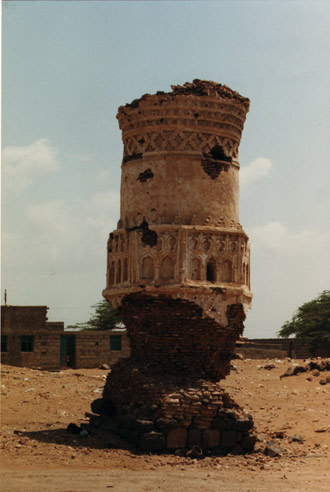Nancy Um
The Merchant Houses of Mocha: Trade and Architecture in an Indian Ocean Port
University of Washington Press
270 pages, 9 x 6 inches
ISBN 978 0295989112
Most people associate the word mocha with coffee. For some it may be a type of coffee bean with a rich deep taste, usually from Yemen or the Horn of Africa. It may also refer to a sugary concoction of coffee mixed with chocolate. For espresso aficionados, a moka is an hourglass-shaped stovetop coffee maker that percolates the beverage upward through the use of steam pressure.
This book brings the term Mocha back to its historical root—a port city on the Red Sea coast of Yemen that the Ottomans cultivated in the early sixteenth century. Known in Arabic as al-Mukha, this small but vibrant port bustled with activity through the nineteenth century. Merchants and pilgrims arrived at Mocha’s jetty from South Asia, the Persian Gulf, the East African coast, other cities in the Middle East and Europe.
The Merchant Houses of Mocha considers the social structure, the key personalities, the urban shape and the architecture of this vibrant city during the late seventeenth and early eighteenth centuries, an era when merchants flocked to it in search of valuable commodities such as coffee, but also spices, bulk metals, Indian textiles, aromatics and dyestuffs.
My main contention is that the practices and the protocols of cross-cultural trade were not just economically significant to the city’s livelihood. Rather, the social, cultural, and even spatial dimensions of the trade played a shaping role in determining Mocha’s societal structure, its urban form and layout, the character of its institutions, and its architecture. Furthermore, the effects of the Indian Ocean trade, as filtered through the city of Mocha, penetrated into the heartlands of the southern Arabian Peninsula, reaching even its most inaccessible and remote mountain fortresses.

The cultural effects of the wider Mocha trade network stretched into the mountains of the Arabian Peninsula and across the Indian Ocean to South Asia, often becoming visible through built nodes—houses, mosques, cisterns, and charitable structures—which were constructed in Mocha, but also in the highlands of Yemen and the port city of Surat in Gujarat.
I embarked on the first stages of research for this book over ten years ago as a graduate student at UCLA, where I was doing my PhD in Islamic art and architectural history. The vibrant, multicultural and migratory population of Los Angeles sparked my interest in the movement of people and the diverse and itinerant urban communities that result from these migrations.
But, such urban diversity is hardly singular to the contemporary moment. The Indian Ocean facilitated the transit of people and goods across extended sea journeys that have connected continental masses fluidly since antiquity. Thousands of miles away from Los Angeles on the Pacific, the early modern city of Mocha on the Red Sea adjacent to the Indian Ocean, with its diverse, multi-ethnic, multi-religious, multi-lingual and itinerant population, emerged as a prime site for such an inquiry.
When I first visited the city of Mocha in 1996, I found that its historic core had been largely destroyed, partially as a result of historic acts of aggressions against the port. For instance the French bombed it in 1737 and the Italians in 1911. Additionally, the trade of the port definitively declined in the nineteenth century when other neighboring ports were chosen to replace Mocha’s prime status, such as Aden by the British and al-Hudayda by the Ottomans.
As any recent visitor to the city will attest to, the present port city is quite impossible to decipher because so few buildings from past centuries remain today. Unlike other historic cities where modern building has been inserted within the earlier fabric, in the case of Mocha, the historic heart has been largely abandoned. The majority of Mocha’s current residents live outside of the previous limits of the city wall, which has been reduced to small and sparse mounds of crumbled brick and rubble ruins.
As a result of this urban decay, my work turned to the spatial reconstruction of the site, relying mostly on texts, both published and archival, but also other types of visual materials, such as historic maps, photographs, and prints. The Merchant Houses of Mocha offers a reconstructed image of this now-ruined city during the late 17th and early 18th centuries. By identifying the locations of earlier residential quarters and the city’s major institutions that no longer stand, such as the retail market and the prison, I put Mocha’s pieces back together.
Beyond architectural reconstruction, I endeavored to capture the social dimensions of port city life. Again, this brings us back to Los Angeles, which, while emblematic as a diverse city, is marked by extreme social stratification. A fixed social hierarchy also dominated Mocha’s urban order. Unlike the traditional social structure of other parts of Yemen, where one’s status was tied to family lineage, tribal affiliation, religious identity, and occupation, this coastal hierarchy privileged the maintenance of the trade as its key prerogative.
The governors of Mocha came from the interior regions of Yemen and oversaw the trade in the interest of filtering its revenue back into the center of Yemen. Ship-owning merchants from the northwestern Indian province of Gujarat and their nakhudhas, or sea captains, were considered to be the city’s main elite. The Baniyans, Hindu and Jain commercial brokers who served as translators, intermediaries, and moneychangers in Mocha, were perhaps the most interesting and least understood of Mocha’s communities. While they were socially marginalized according to their dhimmi (protected religious minority) status, they received certain advantages from the local government because of their economically central role in the maintenance of the trade.
On the quintessential questions about the relationship of the port city to its hinterland and foreland, which have long occupied port city studies, I moved beyond the expected analyses of the economic flows of revenue and assumed fiscal imbrications between center, port, and overseas. The cultural effects of the wider Mocha trade network stretched into the mountains of the Arabian Peninsula and across the Indian Ocean to South Asia, often becoming visible through built nodes—houses, mosques, cisterns, and charitable structures—which were constructed in Mocha, but also in the highlands of Yemen and the port city of Surat in Gujarat.
While the tight and age-old maritime relationship between Yemen and India has been acknowledged duly by previous scholars, the role that the Indian Ocean trade played in penetrating the most remote areas of the southern Arabian Peninsula has not been studied. These areas are often featured as entirely cutoff from external contact, an image that persists even today.

This book intervenes in one of the long-standing issues in Middle Eastern studies regarding the shape and analysis of the Arab city. Urban scholars agree that the conception of the Arab city as a uniform and distinct spatial type with consistent features is inherently flawed, over-essentialized, and drawn from limited examples—the product of the limitations of early Orientalist scholarship.
The Merchant Houses of Mocha was written with the understanding that the Arab city is an evolving concept that must be understood through a diversity of cases and with a focus on the historic and regional specificity of each example. But the goal, particularly in Chapters 5, 6, and 7, was not just to present a counter model to long-standing ideas of a uniform and standard Arab city, but also to provide new avenues to analyze the shaping impulses behind the construction, use, and meaning of urban form in Arab and Islamic cities.
As a key port city on the southern fringe of the Arab world, in communication with the Indian Ocean, Mocha presents an important set of spatial and architectural principles that contribute to our understanding of historic urbanism in the Middle East. It should be added that these regions, the Indian Ocean littoral and the Arabian Peninsula, are often excluded from the scholarship on urbanism in the Arab and Islamic world, which usually focuses on key well-known examples from North Africa and the eastern Mediterranean.
My treatment of Mocha looks to the ways in which this city was shaped over time to accommodate the practices of the trade, which included the everyday exchange of goods, but also the social activities of merchants and the representation of status and creditworthiness as necessary attributes for merchants who worked in foreign lands. To that end, the city was laid out in a diagrammatic manner, which was read differently by those who arrived from land and by sea.
Surprisingly, Mocha lacked traditional public structures of trade, caravanserais and funduqs. Houses, which are often cast as the protected private domain of the family, became sites for trade transactions for major merchants. Additionally, while the city was divided along ethnic and religious lines, with the Somali and Jewish communities settled in quarters outside of the city wall, Baniyan merchants were exempt from spatial segregation because of their centrality in the trade.
While Mocha should not be taken as a paradigmatic example of an Arab city, a port city, or an Indian Ocean city, it does present a fascinating case of how the processes of trade shape city form and intersect with the politics of urban functionality in coastal regions.

The goal was not just to present a counter model to long-standing ideas of a uniform and standard Arab city, but also to provide new avenues to analyze the shaping impulses behind the construction, use, and meaning of urban form in Arab and Islamic cities.
In the age of the early modern Indian Ocean, Mocha was at the center of a vast maritime network, with a number of cross-regional spheres overlapping in and around the port. Some of the city’s main necessities, such as water and firewood, came from across the Red Sea. Some members of the city’s elite, such as the famous Indian shipping magnate Abd al-Ghafur, never even set foot in Mocha, but were known locally through their ships and ship captains that frequented the port. Commodities that left Mocha were destined for Basra in Iraq, the port city of Surat in Gujarat, Dutch Batavia in Indonesia, and even St. Malo on the coast of Brittany. This was an era when the merchants and officials of Mocha communicated and traded with their cohorts from Asia, Africa, the Middle East, Europe, and even Central America, directly and indirectly.
The Merchant Houses of Mocha appears at a time when the lines that divide global spaces appear to be less rigid and more porous than ever before. New technologies allow us to traverse vast spaces that in the past required the commitment of extended and arduous journeys to cross. In this age of globalization, we often marvel at the ways in which geographic space has been compressed by technologies of communication and transportation.
With the emergence of these new networks, however, Mocha and also Yemen have lost their centrality in global matrices of trade, exchange, and interaction. Mocha’s trade migrated to other neighboring ports and Yemen, after losing its global monopoly on the coffee bean in the eighteenth century, has not discovered the oil riches of its neighbors. Mocha’s contemporary geographic marginality is underscored by the decay that the city has experienced over time.
Although its ports played a key role in cross-cultural trade networks since antiquity, Yemen has been peripheralized and left out of the story of contemporary global interconnectivity, with all of its perceived achievements. With this contemporary context in mind, it is increasingly important to redraw the historic international vectors of maritime movement and cultural exchange to represent a moment in time when Mocha and Yemen were major players in the global sphere.




We don't put paywalls. We don't distract you with ads. We don't sell your data.
Please help to keep this running!